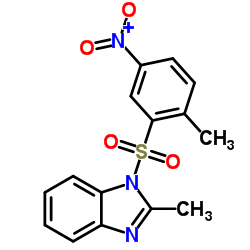93987-29-2
| Name | 2-methyl-1-(2-methyl-5-nitro-benzenesulfonyl)-1H-benzoimidazole |
|---|---|
| Synonyms |
1-<4-methyl-phenylsulfonyl>-3-butyl-2,4,5-trioxo-imidazolidin
1H-Benzimidazole, 2-methyl-1-[(2-methyl-5-nitrophenyl)sulfonyl]- 2,4,5-Trioxo-1-<p-tolylsulfonyl>-3-butyl-imidazolidin 3-Tosyl-1-butyl-parabansaeure 2-Methyl-1-[(2-methyl-5-nitrophenyl)sulfonyl]-1H-benzimidazole |
| Description | BI-6015 is a hepatocyte nuclear factor 4α (HNF4α) antagonist that can inhibit the expression of known HNF4α target genes. BI6015 represses insulin promoter activity through HNF4α antagonism. BI-6015 can be used for the research of cancer and diabetes[1]. |
|---|---|
| Related Catalog | |
| Target |
hepatocyte nuclear factor 4α (HNF4α)[1] |
| In Vitro | BI-6015 (1.25-20 μM; 24-72 h) is cytotoxic to human hepatocellular carcinoma (HCC)[1]. BI-6015 (2.5-10 μM; 5-48 h) inhibits HNF4α gene expression in HepG2 cells[1]. BI-6015 (5 μM; 3 d) induces hepatic steatosis in primary murine hepatocytes[1]. Cell Viability Assay[1] Cell Line: Hep3B-Luc cells and primary hepatocytes Concentration: 1.25, 2.5, 5, 10, 20 μM Incubation Time: 24, 48, 72 hours Result: Was markedly toxic to Hep3B cells but spared primary hepatocytes. |
| In Vivo | BI-6015 (10-30 mg/kg; i.p. once daily for 5 days) induces loss of HNF4α expression and hepatic steatosis in mice[1]. BI-6015 (10-30 mg/kg; i.p. daily or every other day for 20-57 days) induces apoptosis in a human hepatocellular carcinoma mouse model[1]. |
| References |
| Density | 1.5±0.1 g/cm3 |
|---|---|
| Boiling Point | 570.6±60.0 °C at 760 mmHg |
| Molecular Formula | C15H13N3O4S |
| Molecular Weight | 331.35 |
| Flash Point | 298.9±32.9 °C |
| Exact Mass | 331.062683 |
| PSA | 106.16000 |
| LogP | 3.53 |
| Vapour Pressure | 0.0±1.6 mmHg at 25°C |
| Index of Refraction | 1.679 |
